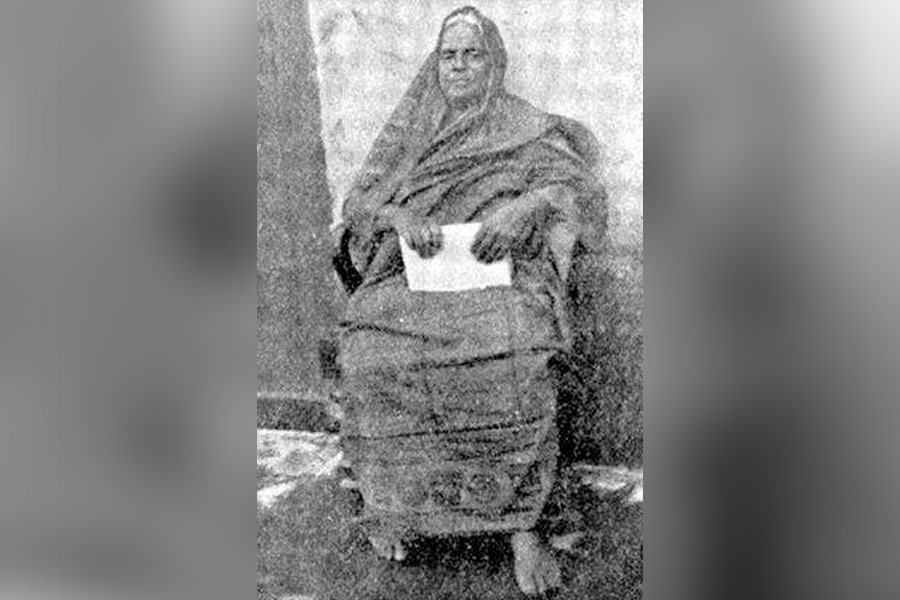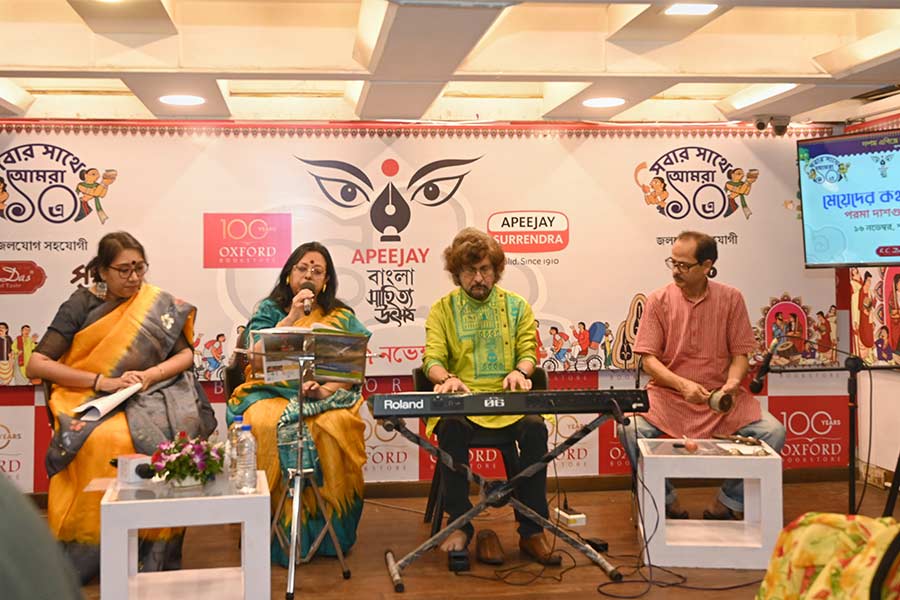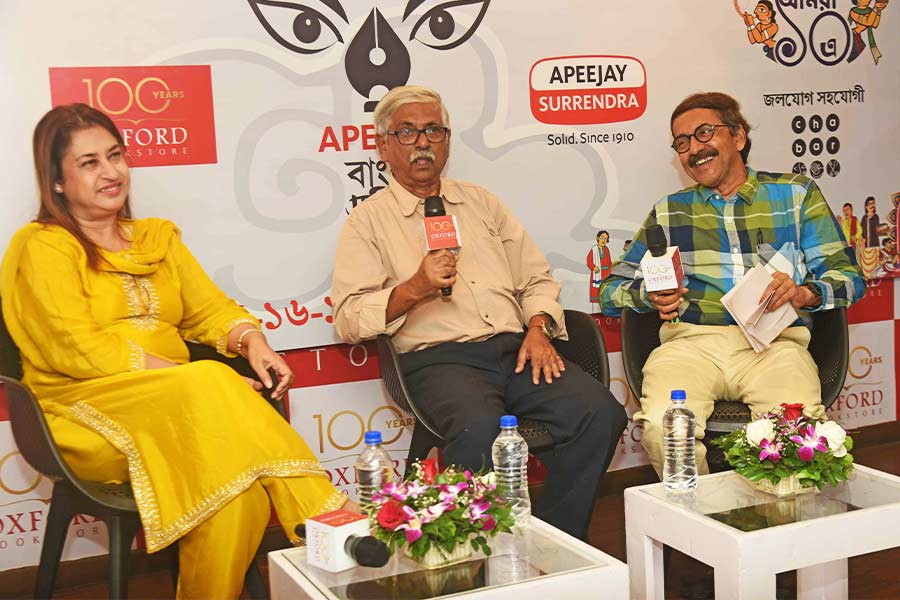Women’s voices in literature were the focus of an engaging discussion at the Apeejay Bangla Sahitya Utsob (ABSU) 2024. The event delved into key milestones in Bengali literature. In an evening of jugalbandi, author and journalist Shyamali Acharya highlighted literary fragments that have influenced academia and social discourse, while singer and social activist Parama Dasgupta used sangeet to complement sahitya.
History and feminism

Shyamali Acharya and (right) Parama Dasgupta Amit Datta
“Whether it is literature or music, women have sometimes spoken for themselves and, at other times, men have spoken for women. If we take a look at the journey of women’s education, which spans around 200 years, we can see how arduous the path has been. While we often celebrate the contributions of Ishwar Chandra Vidyasagar and Raja Rammohan Roy, and the support they received from other men, there has also been opposition — from both men and women,” contemplated Acharya, as she initiated the discussion.
Stressing on the importance of music in language studies, Dasgupta reflected on how, despite the inaccessibility of education for many women, music has provided a powerful outlet for self-expression. Harnessing the power of words, Dasgupta, a student of singer Suchitra Mitra, performed Kazi Nazrul Islam’s Jago Nari Jago Banhishikha. As the stirring lyrics evoked the spirit of feminism, literature turned its gaze to Radha. Describing Radha as a “dynamic and criticised” character from the Puranas, Acharya mentioned about her portrayal by Jayadeva, Vidyapati, Chandidas and Rabindranath Tagore.

Radha by Raja Ravi Verma Wikimedia Commons
The mention of Radha and Rassundari Devi, would make one wonder about the exact moment when history and feminism amalgamated to become feminist history in Bengal. Married at the age of 12, Rassundari Devi’s determination to study became a reality when she was already a mother of 12 children. She taught herself to read and write and empowered herself through education. One of the pioneers of the 1800s, she wrote a powerful autobiography — Amar Jeebon. Her life story marks a milestone in the feminist movement in Bengal, reflecting the many challenges faced by its pioneers over time.
Enlightenment and the Tagore family

Debendranath Tagore, father of Rabindranath Tagore, was a philosopher and religious reformer, active in the Brahmo Samaj Wikimedia Commons
In the Tagore family, female members were educated by women teachers, known as Vaishnavis. The first non-relative to enter the inner sanctum of the Jorasanko home was Ayodhyanath Pakrashi, who taught the women of the household. Debendranath, too, played an active role in the education of the female members of his family.
The literary legacy of the Tagore women

Swarnakumari Devi, Debendranath Tagore’s daughter, was an author too Wikimedia Commons
Debendranath Tagore’s daughter, Swarnakumari, found her true calling in literature and expressed her experiences through her writing. One of her notable works, Deep Nirban, was published anonymously. Swarnakumari was also a talented songwriter, composing Lokkho Bhaiyer Danrer Taaney Bhashlo Rano Tori to inspire the spirit of nationalism among her fellow countrymen. This composition evokes the same sentiment as Chol Re Chol Sobe Bharata Santan. The progressive atmosphere within the Tagore family fostered the interests and talents of both its male and female members, setting a remarkable example for others.
Carrying forward her mother Swarnakumari's literary legacy, Sarala Debi also became an author. She was the first among Debendranath's granddaughters to graduate college and served as the editor of Bharati Patrika. One of her anonymous stories, Premik Sabha, remains memorable to this day. Rabindranath Tagore praised her work, but it also highlighted how publishing anonymously was, until recently, often the only option for women.
Pseudonym and the idea of identity
Author Bhudeb Mukhopadhyay’s granddaughters, Anurupa and Surupa, chose to become authors too. Surupa chose the pseudonym Indira, which remained a secret from her family for a long time. By then, she had already published three books! Anurupa, on the other hand, chose the pseudonym Rani Debi for the Kuntalin competition, a literary contest that started in 1896, but later published her books under her real name.
The daughters of Ramananda Chattopadhyay, the founder of The Modern Review, Shanta Debi and Sita Debi, both selected the same pseudonym, Sanjukta. Their memoirs, travelogues, and other works are still highly regarded today.
The use of pseudonyms by female authors, often to conceal their gender identity, provides insight into the social climate of the time and the evolution of gender identity in literature.
Breaking the stereotype: Inspiring examples

Mankumari Basu broke societal stereotypes with the unconditional support of her husband, who encouraged her to write at least one poem every day Wikimedia Commons
Mankumari Basu, a relative of Michael Madhusudan Dutta, discovered her passion for poetry and broke societal stereotypes with the unconditional support of her husband, who encouraged her to write at least one poem every day. Juggling her domestic responsibilities, she wrote many geeti kabya and novels in diverse genres. Her poem Purandarer Prati Indubala was published in Sangbad Pravakar, with her husband submitting the piece on her behalf.
Kusumkumari, another remarkable poet, also defied the odds to carve out her own literary space. It is said that if someone requested a poem, she would seamlessly multitask between her kitchen duties and literary pursuits to create a piece. Like Mankumari, Kusumkumari enjoyed the encouragement of her husband, who ensured she had a personal space to nurture her craft. Her unfinished memoir, Smiritsudha, remains a must-read for bibliophiles.

Besides contributing to children's literature, Leela Majumdar wrote a cookbook, novels for adults and a biography of Rabindranath Tagore. Her first story, 'Lakkhi Chhele', was published in 'Sandesh' in 1922 Wikipedia
Leela Majumdar, born to Surama Devi and Pramada Ranjan Ray (the younger brother of Upendra Kishor Ray Choudhuri), spent her childhood in Shillong, where she studied at Loreto Convent. Her witty perspectives on gender roles, the “different wave” in the Tagore household, supportive “better halves” challenging societal norms, and women fighting their battles with or without support — all reflect the multifaceted narrative of feminist history in Bengal. The thesis and antithesis of this journey are shared experiences of men and women coexisting in the same space. The evolution of gender identities and roles, shaped by these shared journeys, highlights the paths of both men and women as contributors to this ongoing story.

